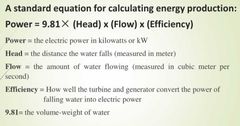![]()
![]()
![]()
Use LEFT and RIGHT arrow keys to navigate between flashcards;
Use UP and DOWN arrow keys to flip the card;
H to show hint;
A reads text to speech;
10 Cards in this Set
- Front
- Back
- 3rd side (hint)
|
Introduction to HP |
* Hydrological cycle gives rise to water energy(water head(potential), kinetic and pressure. * Sun is the main source of energy in the Hydrological cycle. |
|
|
|
Hydropower system |
It converts water energy in flowing water into electrical energy |
|
|
|
How a Hydroelectric Power System Works |
* Flowing water is directed at a turbine(waterwheels). * The flowing water causes the turbine to rotate, converting the water’s kinetic energy into mechanical energy. * The turbine uses the water energy generated and not the actual flowing water. * The water energy is transmitted to the generator by the shaft. * This water energy is received by stator in the generator which is then collected by the magnetic coil to convert the mechanical energy to electrical energy. |
|
|
|
Hydropower system unit |
1. Generator- Rotor, stator 2. Turbine |
|
|
|
Process of HP generation |

|
|
|
|
Factors that influence HP generation |
1. Water head- The height which the water falls. 2. Flow rate(Discharge)- The quantity of water flowing in a given time. It depends on the size of the river and the amount of water flowing in it. NB: The greater the water head and flow rate, the more electricity is produced. |
|
|
|
Standard equation for calculating energy production: |

|
|
|
|
Classification of hydroelectric |
1. According to available water quantity a. Run-off plant without pondage- No water storage b. Run-off plant with pondage- Temporary water storage during off peak periods(night time) and use of this water during peak periods(Day time). c. Reservoir plant- Large size for water storage from wet season to the next dry season.
2. According to availability of water head a. Low head- H<30m b. Medium head- 30<H<60m c. High head- H>60
3. According to nature of load a. Base load plant- Provides a steady flow of power regardless of total power demand by the grid. b. Peak load plant
|
|
|
|
Advantage of HP |
* Operation, running and maintenance costs are low. * Much more reliable than wind, solar or wave power. * Energy is virtually free once the dam is built. * No waste or pollution produced. * No fuel is burnt and the plant is quite neat & clean. |
O M E N N |
|
|
Disadvantage of HP |
* Land-use oriented * Dams are very expensive to build. * Fish migration is restricted. * May cause floods in large regions. * Finding a suitable site can be difficult - the impact on residents and the environment may be unacceptable. * Water quality and quantity downstream can be affected, which can have an impact on plant life. * Capital cost of generators, civil engineering works and cost of transmission lines is very high. |
L D M F |

